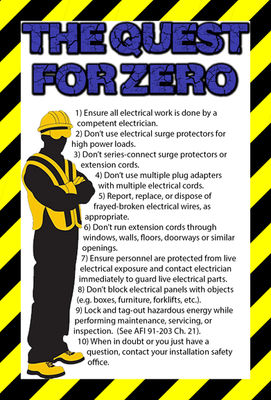WV Local Technical Assistance Program
Tailgate Safety Talks
Workplace Electrical Practices
This Tailgate Talk is part of the NLTAPA collection.

Electrocutions occurring between 1982 and 1994 were studied by the National Institute of Occupational Safety & Health (NIOSH) in 1998. The NIOSH researchers, Kisner & Casini, analyzed 224 electrocutions which resulted in 244 workplace fatalities. These fatalities accounted for approximately 7% of all workplace deaths. The information they learned provides valuable lessons for everyone that works with or around electricity.
Younger males die most often. Victims ranged in age from 17- 70 years, 99% of them were men, 64% died prior to age 35, and 99% of the incidents involved alternating current (AC).
New hires need to take the most care. 41% of all victims were on the job for under 1 year.
Construction workers had the highest percentage of electrocutions at 40%. Other predominate industries included: transportation/communication/public utilities (16%); manufacturing (12%); and agriculture/forestry/fishing (11%).
Utility line workers (linemen) typically receive extensive training in electrical safety, yet they had the highest number of fatal injuries. 55% of linemen fatalities were caused by failure to use required Personal Protective Equipment (PPE) such as gloves, sleeves, mats, or blankets. Laborers, who generally receive little or no electrical training had the next highest fatality rate. NIOSH identified five case scenarios describing the 244 fatalities: 1) Direct worker contact with an energized powerline (28%); 2) Direct worker contact with energized equipment (21%); 3) Boomed vehicle contact with an energized powerline (18%); 4) Improperly installed or damaged equipment (17%); and 5) Conductive equipment contact with an energized powerline (16%).
Here is a partial checklist of basic safe electrical practices to help prevent occupational electrocution:
1. Are employees given and required to use the proper protective equipment and tools when working around electrical hazards?
2. Is there an effective lockout/tagout procedure for work on electrical circuits and equipment?
3. Have employees been advised of the location of hazards and proper protective measures to avoid contact with an energized circuit?
4. Are safe work practices (de-energizing live parts, discharging capacitors, lockout, etc.) used to prevent electrical shock and other injuries?
5. Are portable electrical tools and equipment grounded or double insulated?
6. Do electrical boxes and fittings have approved covers?
7. Are defective, damaged, or frayed electrical cords replaced promptly?
8. Are ground fault circuit interrupters and/or an assured equipment grounding program used on construction sites? Inspect cords and grounds on cords.
9. Are electrical installations in hazardous locations approved for those locations?
10. Is your electrical system regularly checked by someone trained in the National Electric Code?
11. Dielectrically rated boom trucks should be used for electrical work. Do not run wires across the dielectric boom.

